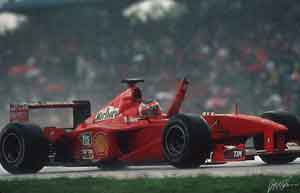Features - News Feature
DECEMBER 10, 2000
The future of the German Grand Prix
BY JOE SAWARD

The problems surrounding the British Grand Prix may have been sorted out in a deal between Silverstone, Brands Hatch and Bernie Ecclestone but the future of another classic Formula 1 race - the German Grand Prix - remains uncertain.
A commercial dispute between the F1 authorities and the new Nurburgring did not help matters and when that was finally settled Hockenheim had a long-term deal for the German GP. The Nurburgring had to content itself with European or Luxembourg status. The good news for both tracks was that German interest in F1 was sufficient for there to be two Grands Prix each year.
It is very unlikely that the either event will be dropped from the F1 calendar in the short term given the involvement in Formula 1 of Mercedes-Benz, BMW, the Schumacher Brothers and Heinz-Harald Frentzen but it is quite possible that Hockenheim could still lose the race.
The problem is that Hockenheim is a very inefficient race track. Although it is one of the longest tracks on the F1 calendar, it has one of the smallest crowds because the vast stadium area can only accommodate 70,000 people and there is no room in other places to increase the numbers. The forests are dense with few roads and environmentalists do not want the whole place to be ruined. Even if it was possible to put in huge new grandstands and access roads, Hockenheim would not really want to do it. The circuit is the fastest in F1 these days and safety is a real problem with such high speeds involved. The only way to move forward, therefore, is to slow the whole place down and shorten the track. There is a small road which goes across the middle of the circuit (called the Ketscher Weg) and if this corridor were to be expanded a new section could be built with enough grandstands to house another 30,000 people. Access would not be an enormous problem as there are already roads which link to the Ketscher Weg from the north and south so an increase in numbers would not necessarily cause any additional traffic problems.
The problem is that the work will require a large amount of money and the cutting down of a large number of trees. There is a very strong environmental presence in Germany and getting clearance for such a change would not be the work of a moment. The German GP contract runs out after the 2001 event so time is an issue.
Hockenheim submitted plans this week for a $29m rebuilding plan which will reduce the length of the track from 4.2 miles to 2.7, getting rid of most of the high-speed section going out to the Ostkurve and back again. This will enable the construction of huge new grandstands and access roads so that the current 70,000 crowd capacity can be increased to make the event more financially viable. The intention is for the new track to hold 100,000 people. The track owners (the Badische Motorsport Club in partnership with the city of Hockenheim) has the support of the state government of Baden-Wurttemberg - which is currently under Christian Democrat control - but there is a strong rival bid from the Social Democratic government of Manfred Stolpe, Minister-President of the state of Brandenburg, in the old East Germany.
Brandenburg has invested $150m in the construction of a vast new motorsport facility in an effort to attract tourism and create jobs to the scenic Lausitzer hills, which lie 60 miles to the south of Berlin.
The Lausitzring facility has been built in an old open-face lignite (brown coal) mine. The 800-acre facility is located near the town of Senftenberg, next to the main Dresden-Berlin A13 motorway. It features a combination of different circuits, including a four mile oval which will be used for vehicle testing by the German car manufacturers. This can be combined with the Grand Prix course (which is 2.8-miles in length). This is built inside a 2-mile tri-oval superspeedway. Earth moved during the mining operations has been used to build huge spectator banks which will allow 120,000 people to watch the action.
There is no secret that the Lausitzring is aiming for a Grand Prix. Next year it will host a round of the CART series.
Formula 1 bosses say that the Lausitzring is really not the right sort of image for F1. The glamour of a converted East German coal mine is somewhat limited and it is all a very long way from nice hotels and glitzy big cities.
The intention is for the Lausitzring to attract crowds from Berlin (which has a population of 3.5m) but there also the cities of Dresden (475,000) and Leipzig (481,000) which are closer. The circuit is only 125 miles from Prague in the Czech Republic (1.2m people) and 150 miles from the Polish cities of Wroclaw (641,000) and Poznan (582,000).
Ironically, the big West German cities are further afield with Frankfurt, Stuttgart and Munich both being around 275 miles away and Bonn/Koln being 320 miles away. In an effort to cater for the fans from the West there are large campgrounds planned at the Lausitzring, Schumacher's army of supporters preferring camping cars to hotels.
But this is unlikely to impress the beautiful people of F1 and one cannot help but feel that the Lausitzring is simply being used as a lever to make sure that Hockenheim does all the work that is needed so that F1 can remain settled there, within easy reach of the nice hotels and pretty towns of Heidelberg, Schwetzingen, Bruchsal and Speyer.